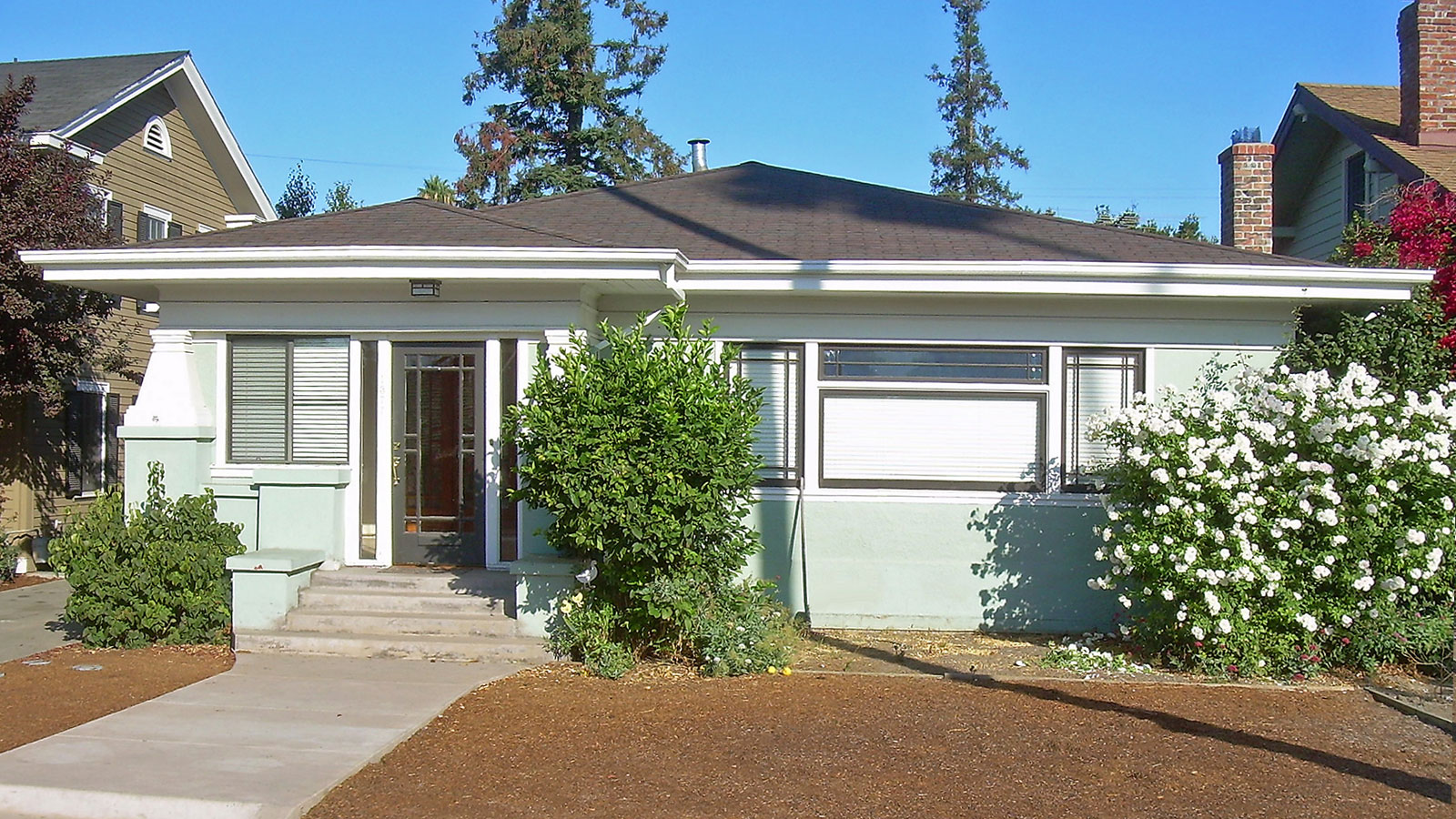The first time I heard of Sonja Trauss, she was mobilizing San Franciscans to support new apartment construction. This was not a campaign that went over well in the Mission District, a formerly working-class neighborhood that was in the middle of a full-on freakout over how many people seemed to want to build luxury condos there. One night, when I was walking down 24th Street, I saw that someone had taped up fliers to telephone poles with pictures of Trauss on them. Her eyes had been whited out and replaced by dollar signs.
Based on this backstory, I assumed Trauss must be one of the numerous young real estate professionals who come to the Bay Area to seek their fortunes. I was surprised, when we met up last week, to realize that she actually belongs to a species I’d thought almost extinct in the Bay Area: the bona fide, deeply eccentric city-government nerd. Even stranger, Trauss had just turned around and done something that seemed to delight even her more vociferous opponents — she was trying to sue a suburban municipality to build more affordable housing.
Here is how Trauss’s thinking goes: We need more housing units, and the market-rate units we build now will become tomorrow’s middle-income apartments. Her theory is based on her experience working for a neighborhood advisory committee in a rapidly gentrifying part of Philadelphia right before the mid-2000s housing bubble burst. “When the market crashed,” Trauss told me, “all those projects we had approved went on sale for a third of the price they would have, while all the projects we gummed up were never built. We lost the opportunity to create more units.”
Trauss’s enthusiasm for building has brought out the critics. They say that, at best, she just doesn’t know her local history (when the mid-2000s housing bubble burst, the Mission was relatively unaffected); at worst, she’s a tool of the real estate lobby, hoping for a payout.
Neither view could be easily squared with Trauss’s latest move — organizing a lawsuit against the East Bay suburb of Lafayette, arguing that the city has wrongly blocked builders from putting up new housing. The lawsuit would be based on the 1982 Housing Accountability Act — an obscure California law intended to help affordable housing projects from having to compromise on density in order to win approval from local planning commissions. In 2011, a court ruled that the act applied to all housing, not just affordable housing. In 2014, a developer in the Mission used the act to fend off an effort to scale down a 12-unit apartment building that they had been trying to build for years on the site of a former Kentucky Fried Chicken.
But Trauss’s new effort seems to be unprecedented — it would be the first time that actual people, rather than developers, were using the law. And if her campaign succeeds, the implications could be huge. Suburbs like Lafayette are historically allergic to allowing more housing density, yet denser communities, many urban environmentalists believe, are the key to kicking our climate-wrecking carbon habit. Trauss’s suit could upend the tidy universe of California suburbia: Google employees living in San Francisco and commuting down the peninsula by tech bus could potentially could sue Mountain View for its refusal to approve three-quarters of the proposed housing around the Google campus. Speculators could ride BART and Caltrain all over the Bay Area, looking for locations around transit hubs where community organizations had blocked development.
Here’s how Trauss came to Lafayette: In August, she read a news article about the well-to-do suburb located east of San Francisco, over the hills from Oakland. Average income in Lafayette is about $130,000 — double the state average. It has an excellent school system and its own BART stop, and, like many similar communities, is determined to stay suburban. The Bay Area may have acquired 270,000 new residents in the last five years, but that doesn’t mean Lafayette is working to make room for them.
In 2010, Lafayette tried to rezone a Christmas tree lot that had been zoned for apartments in the 1940s, down from 35 units per acre to one home per five acres. The rezoning never went through. Then in 2011, a developer came up with a plan to build 315 apartments on the land (about 15 units per acre). The plan was to rent the finished units out, starting at $1,500 per month for a one bedroom — a price that, by Bay Area standards for new construction, was fairly modest, especially for an area with a good school district.
Neighborhood backlash was swift: “This development project will significantly impact traffic, threaten the safety of children crossing the street on their way to school, and decrease property values of hundreds of homes,” one petition read. The city refused to approve the project. The developer threatened to sue Lafayette under the Housing Accountability Act, but backed down when Lafayette offered to buy half of the land and turn it into a 10-acre city park. The developer drew up plans to build 44 more expensive single-family detached homes on the property instead.
But because of a quirk in the Housing Accountability Act, the developer wasn’t the only person who could sue Lafayette. Any person who could make a case that they would have lived in one of those 315 apartments, had they been built, could sue the City of Lafayette for standing in their way.
Right now, Trauss has a legal team and 15 plaintiffs lined up. She’s looking for more. The group also plans to host a panel discussion at the Lafayette Public Library titled: “Why are we suing you?”
Trauss has been obsessed with local politics since the days when she started writing the newsletter for her neighborhood organization in Philadelphia. She can rattle off the permit history of every major housing development that has gone up in the Bay Area in the last three years. “When we’re all there at a deep-level city meeting all night,” says Trauss, “I feel like I have more in common with the other people at the meeting than with anyone not at the meeting, even if we’re on opposite sides of an issue, because we’re all the type of people who think this is a good way for us to spend our lives.”
When Trauss moved to the San Francisco Bay Area four years ago, she first lived in El Cerrito with a relative whom she helped get through chemo. (“It’s a country club model moving here,” she said. “Either you have to pay a huge up-front fee, or you need to know someone.”) She found work quickly, teaching math at a private high school. But finding a place to live was an ordeal.
“I was just sick of ranting with my friends about how hard it is to find a place,” she says. “My four friends and I could go to the Planning Commission every Thursday and make our same speeches that we make at the bar about how we need to build more, build faster, build everything someone wants to build — and we might actually do some good. Local politics is where it’s at. People say ‘Oh, I’m so disconnected from politics. Nothing I say or do matters.’ That’s only because they’re paying attention to national politics. Local politics? You can take it over. If you’re bored with going to the bar every night and getting drunk, you can just take over your town. If you feel like it.”
Trauss and her friends decided to call themselves the San Francisco Bay Area Renters Federation — or, for short, SFBARF. The acronym was deliberate; Trauss’s roommate insisted that you couldn’t buy branding like BARF, and no one would ever confuse them with anyone else. (The current lawsuit is organized under a new, less creatively acronymable name: the California Renters Legal Advocacy & Education Fund.)
The ultimate goal is not to torment Lafayette so much as to fire a warning shot across the bow of all the Bay Area suburbs who have failed to take on their share of new residents. “I talked to Sam Altman, the head of Y Combinator,” Trauss says. “He told me that Y Combinator alone creates 10,000 new jobs a year in the Bay Area. That means we need 5,000 new homes. At least.”
That said, Lafayette Terraces, the 315-unit complex that inspired the lawsuit, is far from a poster child for smart growth. Those 315 apartments were going to come with over 500 parking spaces, made necessary because the development is a nearly 40-minute walk away from the Lafayette BART station. A high density building’s environmental value vanishes if the people who live densely still drive everywhere. Many of the things that Lafayette residents objected to about the project — increased pollution from traffic near the complex, in particular — made sense.
That’s the argument that the mayor of Lafayette — attorney and former Ecology Law Review editor Brandt Andersson — made when he debated SFBARF member Brian Hanlon on television station KTVU. Andersson felt SFBARF’s pain, he said. He himself had a kid in his 20s who was still living in the home. But in its enthusiasm to find a test case, Andersson argued, the group had ignored the specifics of Lafayette as a city.
For one thing, since the city had never formally turned down the development, SFBARF didn’t have much of a case. For another thing, Lafayette had drawn up a plan, made three years ago, to keep multi-unit housing downtown, near the BART station. “We don’t want high-rises,” Andersson said — the plan called for a maximum of three stories in height, and 35 units per acre. But over the last few years the city had approved several apartment complexes downtown, and had optioned a city-owned parking lot to a developer to build 24 units of workforce housing.
All fine and good, said Hanlon, but still not enough — between 2007 and 2013 Lafayette had only signed off on permits for 10 percent of the amount of low-income and moderate-income housing that the Association of Bay Area Governments recommended built to keep up with population increase in the area. (Overall, though, Lafayette built 65 percent of the recommended number of units, which is a higher percentage than San Francisco.)
Trauss objects to Andersson’s characterization of the development as too far out of town. An ordinary person could walk the 1.7 miles to downtown, she responded, and a not very in-shape person could bike. Plus, she adds, “It’s almost always true that new development doesn’t have the transportation infrastructure (this includes walking friendly roads, not just buses and whatnot) it needs at the time it’s developed. That’s because we don’t build transportation (or really do anything) unless there are people asking for it. So if we let ‘not enough transportation’ be a reason to not build (and often we do), almost nothing will get built.”
That said, this case has always been about something bigger than Lafayette. “It’s not just a lawsuit,” says Trauss. “It’s a political exercise. Most people would be very uncomfortable tearing down 315 houses. But they don’t have a similar objection to never building them in the first place, even though I feel they’re morally equivalent. Those people show up anyway. They get born anyway. They get a job in the area anyway. What do they do? They live in an overcrowded situation, they pay too much rent, they have a commute that’s too long. Or maybe they outbid someone else, and someone else is displaced.”
“It’s easy to see the problem when you’re tearing down someone’s home. But when you’re not building, it’s hard to see whose home it is.”



